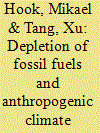|
|
|
Sort Order |
|
|
|
Items / Page
|
|
|
|
|
|
|
| Srl | Item |
| 1 |
ID:
117293


|
|
|
|
|
| Publication |
2013.
|
| Summary/Abstract |
Future scenarios with significant anthropogenic climate change also display large increases in world production of fossil fuels, the principal CO2 emission source. Meanwhile, fossil fuel depletion has also been identified as a future challenge. This chapter reviews the connection between these two issues and concludes that limits to availability of fossil fuels will set a limit for mankind's ability to affect the climate. However, this limit is unclear as various studies have reached quite different conclusions regarding future atmospheric CO2 concentrations caused by fossil fuel limitations.
It is concluded that the current set of emission scenarios used by the IPCC and others is perforated by optimistic expectations on future fossil fuel production that are improbable or even unrealistic. The current situation, where climate models largely rely on emission scenarios detached from the reality of supply and its inherent problems are problematic. In fact, it may even mislead planners and politicians into making decisions that mitigate one problem but make the other one worse. It is important to understand that the fossil energy problem and the anthropogenic climate change problem are tightly connected and need to be treated as two interwoven challenges necessitating a holistic solution.
|
|
|
|
|
|
|
|
|
|
|
|
|
|
|
|
| 2 |
ID:
166723


|
|
|
|
|
| Summary/Abstract |
A number of official energy forecasts—including those compatible with the aspirational 1.5 °C Paris Accord global temperature rise limit—see both global primary and net energy use continuing to rise, even out to 2100. Various technologies, including greatly increased use of renewable and nuclear energy, negative emission technologies such as direct air capture, and geoengineering are proposed as approaches for meeting the 1.5 °C target. In contrast, we argue that meeting this target and avoiding significant increases in extreme weather events will require marked reductions in future energy demand. We argue that the combined fossil fuel and renewable net green energy production will fall in the coming decades, after subtraction of various energy costs essential for ecosystems maintenance, including those needed to stabilise climate. At best, nuclear energy will only fractionally increase its global energy share, because of its high capital costs and political opposition arising from accident risks, waste disposal and proliferation concerns. Geoengineering will not solve fossil fuel depletion, and has serious known—and perhaps unknown—risks. We conclude that global net energy produced in an ecologically sustainable manner will start falling in a decade or so, and suggest the need to account for this at a policy level by introduction of a green EROI—EROIg.
|
|
|
|
|
|
|
|
|
|
|
|
|
|
|
|
| 3 |
ID:
116978


|
|
|
|
|
| Publication |
2012.
|
| Summary/Abstract |
The simulated effects of anthropogenic global warming have become important in many fields and most models agree that significant impacts are becoming unavoidable in the face of slow action. Improvements to model accuracy rely primarily on the refinement of parameter sensitivities and on plausible future carbon emissions trajectories. Carbon emissions are the leading cause of global warming, yet current considerations of future emissions do not consider structural limits to fossil fuel supply, invoking a wide range of uncertainty. Moreover, outdated assumptions regarding the future abundance of fossil energy could contribute to misleading projections of both economic growth and climate change vulnerability. Here we present an easily replicable mathematical model that considers fundamental supply-side constraints and demonstrate its use in a stochastic analysis to produce a theoretical upper limit to future emissions. The results show a significant reduction in prior uncertainty around projected long term emissions, and even assuming high estimates of all fossil fuel resources and high growth of unconventional production, cumulative emissions tend to align to the current medium emissions scenarios in the second half of this century. This significant finding provides much-needed guidance on developing relevant emissions scenarios for long term climate change impact studies.
|
|
|
|
|
|
|
|
|
|
|
|
|
|
|
|
| 4 |
ID:
126525


|
|
|
|
|
| Publication |
2013.
|
| Summary/Abstract |
A model is presented in this work for simulating endogenously the evolution of the marginal costs of production of energy carriers from non-renewable resources, their consumption, depletion pathways and timescales. Such marginal costs can be used to simulate the long term average price formation of energy commodities. Drawing on previous work where a global database of energy resource economic potentials was constructed, this work uses cost distributions of non-renewable resources in order to evaluate global flows of energy commodities. A mathematical framework is given to calculate endogenous flows of energy resources given an exogenous commodity price path. This framework can be used in reverse in order to calculate an endogenous marginal cost of production of energy carriers given an exogenous carrier demand. Using rigid price inelastic assumptions independent of the economy, these two approaches generate limiting scenarios that depict extreme use of natural resources. This is useful to characterise the current state and possible uses of remaining non-renewable resources such as fossil fuels and natural uranium. The theory is however designed for use within economic or technology models that allow technology substitutions. In this work, it is implemented in the global power sector model FTT:Power. Policy implications are given.
|
|
|
|
|
|
|
|
|
|
|
|
|
|
|
|
|
|
|
|
|